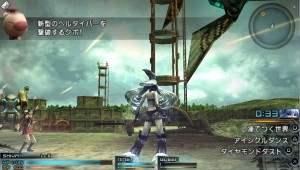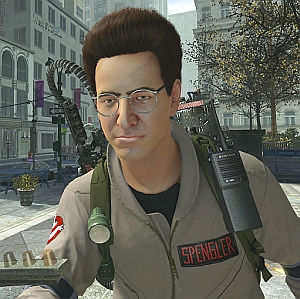Most Recent: PSP
Insert Quarter: The Rise and Fall of THQ’s Empire

Insert Quarter is our showcase for some of the best and most interesting writing about video games on the Internet.
Gamers often didn’t know what to make of THQ. The publisher built its empire on the backs of tie-in games based on Nickelodeon and Pixar properties such as SpongeBob SquarePants and The Incredibles. But they also produced intriguing original games such as Saints Row: The Third and Darksiders. They were even the initial driving force behind Evolve, one of 2015’s most anticipated games. But that all changed when the company went bankrupt early last year.
So what happened? Tracey Lien, writing for Polygon, set out to discover the answer by talking to as many former THQ employees as she could including the charismatic (but possibly crazy) Danny Bilson. Her portrait of a publisher in free fall makes you wonder, could anything have been done?
Many blame the company’s fall on the licensed games well drying up. Some pin it on the commercial failure of the company’s uDraw tablet for the PlayStation 3 and Xbox 360. Others point to poor management and too many risky bets.
“There isn’t any one, isolated event that killed the company,” says a former THQ executive who asked to not be named. “This was one of the most successful video game businesses in America. We were a billion dollar company. It was complicated.”
THQ suffered a “death by a million spider bites,” the executive says.
The full article is available for your perusal at Polygon.
Insert Quarter: Unreleased Games and the People Who Trade Them

Insert Quarter is our showcase for some of the best and most interesting writing about video games on the Internet.
Unreleased games will always be of interest to gamers. Who among us wouldn’t be interested in Nintendo’s 64DD version of Mother 3 or Free Radical’s late, lamented Star Wars: Battlefront 3. But these games have managed to live on thanks to a shadowy network of collectors and archivists who trade and preserve the neglected pieces of gaming history. Kotaku UK’s Leon Hurley sought out some of these amateur historians to get the complete story on the trading of unreleased games:
You’ve probably seen videos of unannounced or cancelled games. Not necessarily the older retro stuff, but more recent things like Star Wars Battlefront 3 or Stranglehold 2. Did you know there’s a keen, and occasionally zealous, culture of collectors and traders passing these things around?
[…]
There are many levels to all this. Some simply collect and play the games, others code and and hack, extracting fresh info from old files or reinstating missing features. There’s even a community quite happily extracting and modding Halo maps. For others it’s about preserving the often transient world of video game history.
The full article is available at Kotaku UK.
Insert Quarter: Remembering the Best Instruction Booklets Ever

Insert Quarter is our showcase for some of the best and most interesting writing about video games on the Internet.
Creating a beautiful and engaging instruction booklet has become a lost art in today’s go-go world of downloadable games and extensive in-game tutorials. Some, like Yacht Club Games and their awesome booklet for Shovel Knight, are attempting to keep the practice alive. But it seems like a foregone conclusion that the instruction booklet will have breathed its last in the not-too-distant future.
Thankfully, Jason Dafnis of Game Informer took some time out of his day to honor ten of his favorite instruction booklets, manuals, and strategy guides:
Let me spin you a yarn. Times were, you’d open that brand-new cardboard (or plastic) box and there, nestled right next to your cartridge (or disc), would be a booklet. Yes, a booklet – paper pages stapled together that told you how to play the game (and sometimes more). Remember those?
Now the left (or right) side of your game case sits bare or thinly veiled with tie-in ads or DLC codes. Those clippies that once held your booklet are all but obsolete. Booklets might not be completely extinct, but they are on the way out. Here are ten of our favorites in no particular order.
The full article is available at Game Informer.
Insert Quarter: Video Game Titles Have Gotten Ridiculous

Insert Quarter is our showcase for some of the best and most interesting writing about video games on the Internet.
Video game titles have gotten ridiculous. I think I really noticed it earlier this year when Crystal Dynamics and Square Enix decided use Rise of the Tomb Raider as the title of the next game in the series. I’d gotten my fill of the word “rise” (and its variants) after being subjected to The Dark Knight Rises, Rise of the Planet of the Apes, G.I. Joe: The Rise of Cobra, Hannibal Rising, and many others at the movie theater. Especially because very few of the people or groups who are supposed to rise in those movies actually do!
Destructoid’s Steven Hansen shares my pain and has put together his own list of words that need to be stricken from game titles. Unsurprisingly, it all loops back to Call of Duty:
Lords of the Fallen and Call of Duty: Advanced Warfare just came out and they should be laughed out the damn building for their horrible, generic videogames names.
I originally typed “Armored Warfare” and was confused when Google failed to bring up results for our “Call of Duty: Armored Warfare” review. Then I realized it was “Advanced Warfare” after remembering I kept getting it confused with Advance Wars originally.
DO YOU SEE THE PROBLEM?
You can read the rest of the article at Destructoid.
Insert Quarter: A Profile of the Video Game Archivists at the Library of Congress

Insert Quarter is our showcase for some of the best and most interesting writing about video games on the Internet.
With more than 6,000 titles, the Library of Congress is home to one of the largest video game archives in the world. But the curation and management of the collection is in the hands of just four part-time employees. BuzzFeed’s Joseph Bernstein reached out to these four men to learn how the Library of Congress is attempting to preserve America’s gaming heritage and how much more still needs to be done:
No, the work of game copyrighting and archiving at our country’s signal institution for cultural preservation is not done by a dedicated full-time staff. Instead, it’s the passion project of a handful of archivists who want to be the new standard-bearers in the preservation of video games. Indeed, the state of video game collection at the Library is something of an expression of the liminal state of video games in American popular culture writ large. The Library recognizes the cultural importance of video games, but only devotes four people part-time to their archiving; Game companies insist that their products are the medium of the future, but don’t trust archives with their source code; Collectors sell their troves on Craigslist and eBay rather than considering donation.
Even to get to this point, though, has been a journey in and of itself.
You can read the rest of the article at BuzzFeed.
Transformers: Dark Spark, Valiant Hearts, Grid: Autosport, more added to PS Store

We’re getting an incredibly diverse selection of new games in this week’s PlayStation Store update.
The biggest new game is Activision’s latest Transformers adaptation, Transformers: Rise of the Dark Spark. The title merges the Transformers movieverse with High Moon’s popular War For/Fall of Cybertron games, though Edge of Reality is the developer on this installment. Rise of the Dark Spark is available to download for the PS3 and PS4.
On the complete opposite end of the spectrum from gigantic robots bashing each other is Ubisoft’s Valiant Hearts: The Great War. This puzzle platformer, which is also available for the PS3 and PS4, is set during World War I and features a unique hand-drawn art style.
Other new releases available this week include…
- Grid: Autosport (PS3), the latest installment in Codemasters’ popular racing series.
- BlazBlue: Chronophantasma, a Vita release of the one-on-one fighting game.
- XBlaze Code: Embryo (PS3, Vita), a visual novel prequel to the BlazBlue series.
- Shin Megami Tensei Devil Summoner 2: Raidou Kuzunoha vs. King Abaddon (PS2 Classic), the cult RPG series is back with another classic entry.
More information on all of these games (as well as a few others) can be found after the break. And a complete rundown of this week’s new game add-ons can be found at the PlayStation Blog. (more…)
Final Fantasy Type-0 and Final Fantasy Agito announced for North America
 North American Final Fantasy fans can finally rejoice: Square Enix has announced that Final Fantasy Type-0 and Final Fantasy Agito are finally coming to our shores. Final Fantasy Type-0 was only available on the PSP in Japan, but will be coming to the PlayStation 4 and Xbox One remastered in HD. Final Fantasy Agito, meanwhile, will be coming to iOS and Android devices.
North American Final Fantasy fans can finally rejoice: Square Enix has announced that Final Fantasy Type-0 and Final Fantasy Agito are finally coming to our shores. Final Fantasy Type-0 was only available on the PSP in Japan, but will be coming to the PlayStation 4 and Xbox One remastered in HD. Final Fantasy Agito, meanwhile, will be coming to iOS and Android devices.
Hajime Tabata, Final Fantasy Type-0’s director, said, “The voice of our Western fans was instrumental in the development of Final Fantasy Type-0, and we’re very excited to release this title soon… The new PlayStation 4 system and Xbox One gaming and entertainment platform have really helped to re-envision this dynamic and turbulent world of Orience [the setting of both games].”
Neither game has a confirmed release date yet, though Square Enix did say that Final Fantasy Agito will be a free download with in-app purchases.
Hit the jump for the full press release. (more…)
Harold Ramis, the man who gave the world Ghostbusters, has died
 This is only tangentially related to video games, but it would be a huge disservice for Warp Zoned to ignore today’s passing of one of the greatest comedic minds of the 1980s and 1990s: Harold Ramis. Ramis died this morning due to complications from autoimmune inflammatory vasculitis, a rare disease that affects the blood vessels. He was 69.
This is only tangentially related to video games, but it would be a huge disservice for Warp Zoned to ignore today’s passing of one of the greatest comedic minds of the 1980s and 1990s: Harold Ramis. Ramis died this morning due to complications from autoimmune inflammatory vasculitis, a rare disease that affects the blood vessels. He was 69.
Ramis is best known to film fans for his appearance in 1984’s Ghostbusters as Dr. Egon Spengler. He also co-wrote the film and reprised the role in 1989’s Ghostbusters II. In 2009, he and writing partner Dan Aykroyd would team up again to resurrect the paranormal scientists in Atari’s Ghostbusters: The Video Game. Once again slipping into the character’s signature deadpan delivery, Ramis provided vocals for Egon in the game.
In addition to the Ghostbusters franchise, Ramis was responsible for more than a few movies you may have heard of. He wrote and starred in Stripes, wrote National Lampoon’s Animal House, directed National Lampoon’s Vacation, and wrote and directed Caddyshack and Groundhog Day. If you took a regular Twinkie and said that it represented the career of your average writer/director/actor, Harold Ramis’ Twinkie would be 35 feet long and weigh approximately 600 pounds. In other words, that’s a big Twinkie.
Our thoughts go out to the Ramis family.







